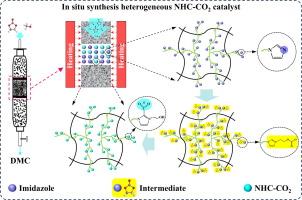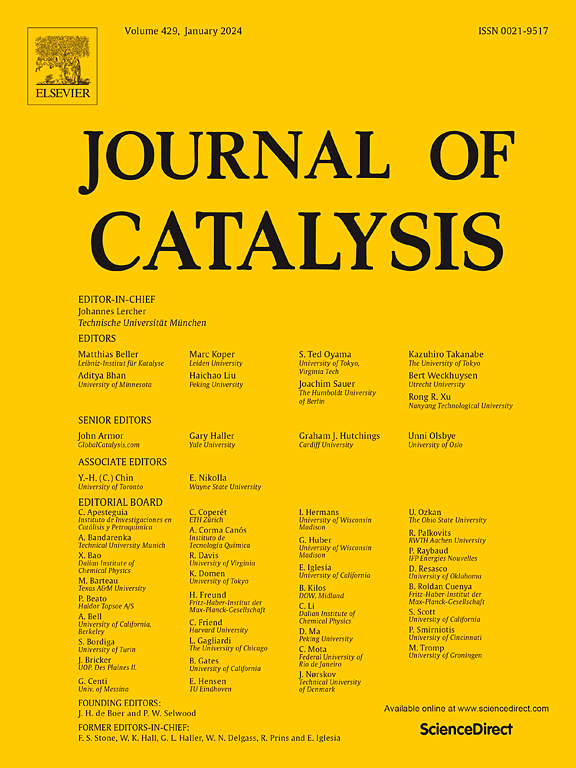原位合成用于连续生产二氯甲烷的 NHC-CO2 异构催化剂
IF 6.5
1区 化学
Q2 CHEMISTRY, PHYSICAL
引用次数: 0
摘要
n -杂环二氧化碳加成物(NHC-CO2)是典型的两性离子液体化合物,具有较强的亲核性和显著的催化能力。但NHC-CO2对水敏感,制备工艺复杂、污染严重,限制了其广泛应用。此外,大多数报道的NHC-CO2化合物都具有均相催化剂的功能,这对分离提出了相当大的挑战。本研究采用原位绿色合成的方法制备了一种非均相NHC-CO2催化剂PS-IMIL。这种方法不仅防止了催化剂与水的直接接触,而且简化了制备过程,减轻了环境污染。优化了PS-IMIL的合成条件,并对其结构和性能进行了分析。进一步探讨了PS-IMIL的合成机理,并对其动力学进行了研究。结果表明,材料碳酸乙烯(EC)与前驱体之间的相互作用对原位合成PS-IMIL至关重要。制备的PS-IMIL不仅保留了NHC-CO2的催化能力,而且具有不含金属和无卤的特点。PS-IMIL在碳酸二甲酯(DMC)生产中连续使用300 h后,其催化活性和结构保持不变。与同类催化剂相比,PS-IMIL具有优异的催化活性和稳定性。本研究为多相NHC-CO2催化剂的开发提供了坚实的理论和实践参考。合成的PS-IMIL在工业生产DMC和其他碳酸酯方面具有重要的潜力。本文章由计算机程序翻译,如有差异,请以英文原文为准。


In-situ synthesis of a heterogeneous NHC–CO2 catalyst for continuous DMC production
N-heterocyclic carbene CO2 adducts (NHC–CO2) are typical zwitterionic ionic liquid compounds, known for their strong nucleophilicity and significant catalytic ability. However, NHC–CO2 is sensitive to water, and its complex and polluting preparation process limits its widespread application. Furthermore, most reported NHC–CO2 compounds function as homogeneous catalysts, posing considerable challenges for separation. In this study, an in-situ green synthesis method was employed to develop a heterogeneous NHC–CO2 catalyst, PS–IMIL. This approach not only prevents direct contact between the catalyst and water but also simplifies the preparation process and mitigates environmental pollution. The synthesis conditions of PS–IMIL were optimized, and its structure and properties were analyzed. Furthermore, the synthesis mechanism of PS–IMIL was investigated, and its kinetics were also studied. The results indicate that the interaction between the material ethylene carbonate (EC) and the precursor is crucial for the in-situ synthesis of PS–IMIL. The prepared PS–IMIL not only preserves the catalytic ability of NHC–CO2 but also exhibits characteristics of being metal- and halogen-free. Remarkably, the catalytic activity and structure of PS–IMIL remain unchanged after 300 h of continuous use in dimethyl carbonate (DMC) production. Compared to similar catalysts, PS–IMIL exhibits excellent catalytic activity and stability. This study provides a solid theoretical and practical reference for the development of heterogeneous NHC–CO2 catalysts. The synthesized PS–IMIL demonstrates significant potential for the industrial production of DMC and other carbonate esters.
求助全文
通过发布文献求助,成功后即可免费获取论文全文。
去求助
来源期刊

Journal of Catalysis
工程技术-工程:化工
CiteScore
12.30
自引率
5.50%
发文量
447
审稿时长
31 days
期刊介绍:
The Journal of Catalysis publishes scholarly articles on both heterogeneous and homogeneous catalysis, covering a wide range of chemical transformations. These include various types of catalysis, such as those mediated by photons, plasmons, and electrons. The focus of the studies is to understand the relationship between catalytic function and the underlying chemical properties of surfaces and metal complexes.
The articles in the journal offer innovative concepts and explore the synthesis and kinetics of inorganic solids and homogeneous complexes. Furthermore, they discuss spectroscopic techniques for characterizing catalysts, investigate the interaction of probes and reacting species with catalysts, and employ theoretical methods.
The research presented in the journal should have direct relevance to the field of catalytic processes, addressing either fundamental aspects or applications of catalysis.
 求助内容:
求助内容: 应助结果提醒方式:
应助结果提醒方式:


